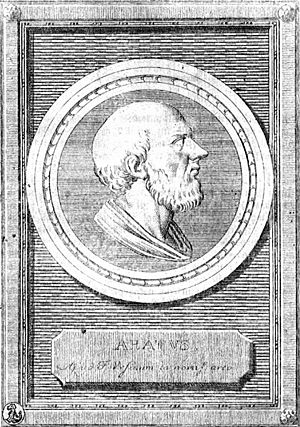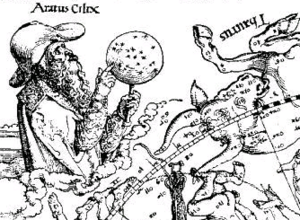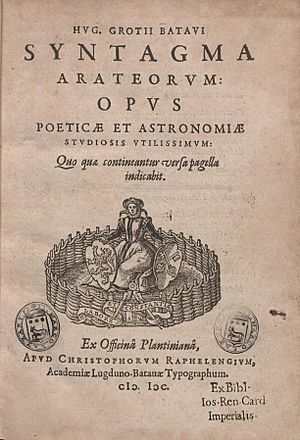Aratus facts for kids
Aratus (born around 315 or 310 BC, died around 240 BC) was an ancient Greek poet. He is famous for his long poem called Phenomena. This poem describes the constellations and other things you can see in the night sky. The second part of his work, called Diosemeia, is mostly about predicting the weather.
Even though Aratus wasn't an expert in Greek astronomy, his poem was very popular. Many people in the Greek and Roman worlds liked it. We know this because many people wrote notes about it, and it was translated into Latin. Some of these old writings still exist today!
Contents
Aratus's Life Story
We know about Aratus's life from several old Greek writers. He was born in a place called Soli in Cilicia, though some say he was from Tarsus.
Aratus studied with different teachers in places like Ephesus and Cos. In Athens, he met important thinkers like the Stoic philosopher Zeno of Citium. He also met other famous poets like Callimachus.
Around 276 BC, King Antigonus II Gonatas of Macedonia invited Aratus to his royal court. It was here that Aratus wrote his most famous poem, Phenomena. He also spent some time at the court of King Antiochus I Soter in Syria. Later, he returned to Pella in Macedon, where he passed away before 240 BC. Aratus was interested in many things, including medicine, grammar, and philosophy.
Aratus's Writings
Aratus wrote several poems and letters, but most of them are lost. Only his two main poems about the sky and weather have survived. These two poems are often thought of as one big work, but they are actually separate. The first is called Phenomena (meaning "Appearances"), and it has 732 lines. The second is called Diosemeia (meaning "On Weather Signs"), and it has 422 lines.
About the Phenomena Poem
The Phenomena poem is based on two older prose works by Eudoxus of Cnidus. Eudoxus wrote these works about a hundred years before Aratus. King Antigonus wanted Eudoxus's ideas turned into poetry, which is why Aratus wrote Phenomena. Aratus closely followed Eudoxus's descriptions in his poem.
The main goal of Phenomena is to introduce readers to the constellations. It explains when they rise and set in the sky. It also talks about the different circles of the sky, like the Milky Way. The poem describes how the Earth stays still while the sky seems to spin around it. It also mentions the path of the Sun through the zodiac.
Aratus wasn't a scientist or an observer himself. So, his descriptions in the poem are not always perfectly accurate. Some of the things he describes couldn't happen at the same time or from the same place on Earth. These mistakes came partly from Eudoxus and partly from how Aratus used the information. Later, a real astronomer named Hipparchus pointed out these differences.
About the Diosemeia Poem
The Diosemeia poem is all about predicting the weather. It uses signs from the sky and also describes how animals react to weather changes. This poem seems to be inspired by the Greek poet Hesiod. Even the famous Roman poet Virgil copied some parts of it in his own poem, Georgics.
The information in Diosemeia mostly comes from Aristotle's Meteorologica and Theophrastus's On Weather Signs. Neither of Aratus's poems talks about Hellenistic astrology.
Aratus's Lasting Influence
Aratus's two poems were very popular in both the Greek and Roman worlds. Many people wrote notes about them, and they were translated into Latin. Other important Greek poets, like Theocritus and Callimachus, admired Aratus.
Roman poets also liked his work, including Ovid and Virgil. Famous Romans like Cicero and Germanicus (who was part of the imperial family) even made their own Latin versions of Phenomena.
Aratus is also mentioned in the Bible. In the Book of Acts (chapter 17, verse 28), Saint Paul quotes a line from Aratus's Phenomena when he talks about God:
|
Ἐκ Διὸς ἀρχώμεσθα, τὸν οὐδέποτ' ἄνδρες ἐῶμεν |
Let us begin with Zeus, whom we mortals never leave unspoken. |
| —Phenomena 1–5 |
Many people wrote commentaries (notes and explanations) on Aratus's work. Some of these, like those by Theon of Alexandria and Hipparchus, still exist. An Arabic translation was even made in the 800s for the Caliph Al-Ma'mun.
To honor Aratus, a crater on the Moon is named Aratus, and a small planet is called 12152 Aratus.
See also
 In Spanish: Arato para niños
In Spanish: Arato para niños
- Acts 17
- The Hesiodic Astronomia
- Leiden Aratea




